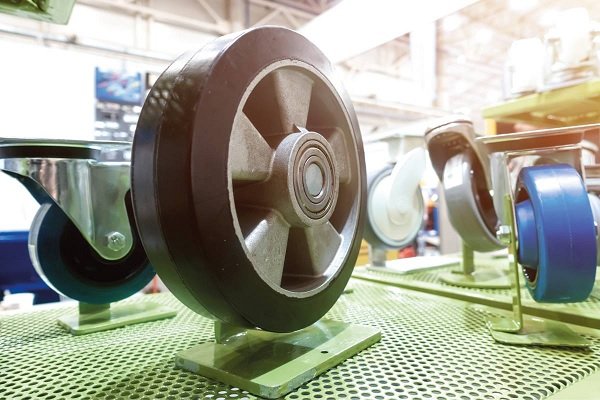Key Takeaways
- Understand the different types of industrial casters and their applications.
- Choose the correct caster based on your specific needs and environment.
- Discover the latest trends and advancements in caster technology.
- Access expert insights on the maintenance and longevity of industrial casters.
An Introduction to Industrial Casters
Industrial casters are unsung heroes in many industries. They assist in the smooth operation by simplifying the movement of heavy equipment and furniture. Whether navigating the aisles of a fulfillment center or maneuvering healthcare equipment in a hospital, the right choice of casters enhances operational efficiency and safety. The concept is straightforward; these wheels are fixed to the base of objects, allowing them to glide rather than being lifted or dragged, which could lead to damage or injury. However, the choice between caster types, such as rigid casters, often dictates their effectiveness in any given scenario. Rigid casters, in particular, are known for their stability and are suited to situations where movement is primarily straight-line, without turning or swiveling. The correct caster type maximizes safety and longevity in varied environments.
Types of Industrial Casters
The world of industrial casters is diverse, with multiple types, each designed to meet specific needs. Swivel casters, for instance, offer the advantage of pivoting, providing excellent maneuverability in tight spaces, making them ideal for hospital rooms and workshops. On the other hand, rigid casters are preferred when equipment needs to be pushed along a consistent path, ensuring stability and control. Locking casters adds another layer of functionality by securing the equipment firmly in place, preventing unwanted movement that could lead to accidents. Understanding these nuanced differences leads to better selection and functionality alignment with the application. The variety of casters available caters to nearly every industrial need, highlighting the importance of specificity in choices to optimize operational efficiency and worker safety.
Key Factors in Choosing the Right Caster
Considerations for choosing the right caster extend beyond simple size and shape. Identifying the appropriate weight capacity is vital. Industrial operations often involve heavy machinery and loads, and overloading a caster could lead to catastrophic mechanical failure or accidents. A thorough assessment of the maximum weight load is paramount, ensuring the longevity and safety of the equipment. Environmental factors, such as temperature and the surface texture on which the casters will be used, also play a crucial role. For instance, environments with extreme temperatures can affect the performance of materials like rubber, which may become brittle or soft. Balancing cost and performance is a significant factor; while opting for cheaper materials might save money upfront, the long-term costs of maintenance and potential replacements often outweigh the initial savings.
Latest Trends in Caster Technology
The caster industry constantly innovates, with new materials and technologies enhancing performance. Polyurethane casters offer advantages over traditional rubber, such as increased durability and a higher load-bearing capacity. These materials reduce wear and extend the lifespan of the caster, representing an excellent return on investment. Another exciting development is the advent of innovative technology in casters. These intelligent casters can monitor their performance and send alerts for maintenance needs, preventing potential failures. Sustainability is also reshaping the caster industry, with manufacturers focusing on reducing environmental impact through better-enduring materials and eco-friendly production processes.
Maintenance and Prolonging Caster Life
Regular maintenance is non-negotiable to ensure the longevity and performance of industrial casters. Establishing a routine that includes regular inspections helps identify early signs of wear and tear. Cleaning to remove debris and potential build-up can prevent unnecessary damage, and consistent lubrication ensures smooth operation throughout the caster’s life. Addressing minor issues before they become significant problems can save time and resources. Ensuring casters are correctly aligned and regularly checked for irregularities contributes to their efficient functioning. Implementing such maintenance routines secures not just the investment in the equipment but also the safety of the personnel who rely on it daily.
Real-World Applications and Success Stories
Casters play a critical role in industries worldwide, often without drawing much attention. Their application can yield transformational results. In warehouse scenarios, upgrading to advanced caster technology has led to optimized material handling processes, reducing the need for excessive labor and increasing throughput. Similarly, installing casters on equipment like hospital beds and carts in the healthcare sector has significantly eased patient transport, enhancing efficiency and care quality.
Expert Tips for Caster Selection and Usage
Industry experts emphasize a comprehensive understanding of the operational environment before selecting casters. Considerations such as environmental conditions, movement frequency, and equipment load are vital in making an informed decision. Avoid common pitfalls like exceeding weight capacity, which undermines performance and poses safety risks.
Proper installation and ensuring correct alignment during setup are crucial. Seeking expert consultation may mitigate potential issues and enhance overall functionality. Tapping into specialist knowledge can elevate the selection process, ensuring that the casters meet and exceed operational needs.
Conclusion: Making Informed Caster Decisions
Selecting the appropriate industrial casters involves knowledge, strategic planning, and understanding specific operational needs. Businesses can enhance safety and efficiency by carefully evaluating caster type, load capacity, and environmental considerations. The industry’s ongoing innovations offer exciting potential to streamline operations further. Remain open to the latest technological advancements to meet your operations’ evolving demands continuously. With the correct information and foresight, making caster decisions can significantly contribute to operational success and cost savings.
